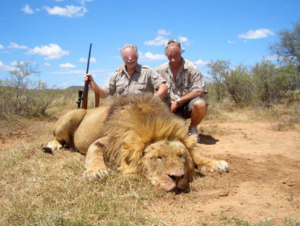News
Latest Lion Aid News
Namibia lion trophy hunting - a shallow report in The Atlantic Magazine
Friday 9th December 2011
|
Richard Coniff, a reporter for the Atlantic, published an article in December this year called “The Circle of Life”. Coniff headed to Namibia with the intent of writing about lion trophy hunting and whether or not it was contributing to the conservation of lions. Yes indeed, he was going to sort this out. The result, of course, was a series of words on paper, badly researched, and paragraphs full of the drama when Coniff saw some lions from a vehicle. He starts out full of vigour, reports that lion populations in Africa are declining, reports that they are increasing in Namibia (?), reports about the petition to the US Secretary of the Interior to put lions on the USA Endangered Species list, and reports on the community initiatives where concessions in Namibia have been given rights of ownership over the wildlife. So far so good. He then says this: “I’m not a hunter, and turning lions into trophies has always struck me as a strange enterprise. But I was inclined to approve of it, in part because of the unequal character of such encounters—we are on foot, in their territory, with animals that can easily kill us”. Immediately he reveals how naïve he is – he has no idea that a lion “hunt” is conducted with baits, the hunter transported in a vehicle, the hunter equipped with a high-powered rifle with a telescopic sight allowing him to shoot the lion from distance, the hunter with odds stacked incredibly high in his favour. Does he really think hunters track lions on foot, slog around Namibian deserts and dunes, and that hunting is “fair chase”? To have done his research well, he should have joined an actual lion hunt. Coniff then interviews a bunch of people – as journalists do. Craig Packer first, who gives information from Tanzania to show that lions have been grossly overhunted – “the only lions left out there with a mane and testicles are youngsters. A male lion needs six years to establish himself in a pride and rear a new generation. Overhunting leads to continual turnover in the pride: when a new male takes the throne, he tends to kill the old crop of cubs so he can father his own”. Next on the interview list were Garth Owen-Smith, Namibia’s “leading conservationist” and Greg Stuart-Hill, a senior conservation planner for the World Wildlife Fund. Both were in support of lion trophy hunting, as it brings in a trophy fee of $10,000 or so in addition to the hunting fees – money talks and the communities would not kill lions eating their livestock anymore, as they now had “value”. The article then fizzles out with a suggestion that photographic tourists might pay an extra fee to photograph lions. Now let’s get to the nitty gritty about Namibia shall we? Things that Coniff should have mentioned but did not? First, Namibia exported 188 trophy lions from 2000-2009 according to CITES. With a rising trend – 65 lion exports during the first five years of that period (2000-2004), and 123 lions during the latter five years (2005-2009). An increase of about 90%. The IUCN estimated in 2006 that Namibia had a lion population of 415-795 lions (all ages and sexes), some shared with Botswana. In the north, where almost all the hunting takes place, the IUCN estimated 315-595 lions (all ages and sexes), but Etosha National Park takes up over 50% of that area and protects most of those lions. Same old story in Namibia as all over Africa – the lions available in hunting concessions are over-harvested. So desperate are the lion hunters that they shoot males radiocollared by research projects (see below). Second, Dr Philip Stander has a long-term research programme called the Desert Lion Conservation Project in northern Namibia outside the protected area of Etosha. “Flip” as he is known, has this to say about trophy hunting – “The regularity, especially since 2004, at which male lions were shot or hunted, and the selection of adult males for trophy hunting, have resulted in a significant reduction of males in the population. It also contributed to vastly different age-specific mortality rates between males and females, that serves to illustrate the negative impact on the population. Increasingly skewed sex ratios, favouring females, have reached critical levels (2010 - 1 adult female : 0.18 adult male). Six of the nine major prides [in the research area where they are trophy hunted] are currently without a pride male”. Flip Stander was not interviewed by Coniff, rather a big journalistic faux pas.
So – is the trophy hunting of Namibian lions conserving them? No in two important ways. Lions are being harvested at unsustainable rates from a small population, causing considerable disruption in pride structure and future reproduction. No also, because the communities supposedly so convinced of the “value” of lions are still poisoning them. At the end of the day the lion “conservation hunting” programme in Namibia has to be seen as the failure it is, and a big re-think is necessary. And please, no more “insight” from reporters like Richard Coniff who attempt to address complicated issues with superficial and badly researched articles. Picture credit: didimalasafari.com Tags: lion trophy hunting, Namibia, Desert Lion Conservation, Categories: Trophy Hunting |
Add a comment | Posted by Pieter Kat at 14:12




